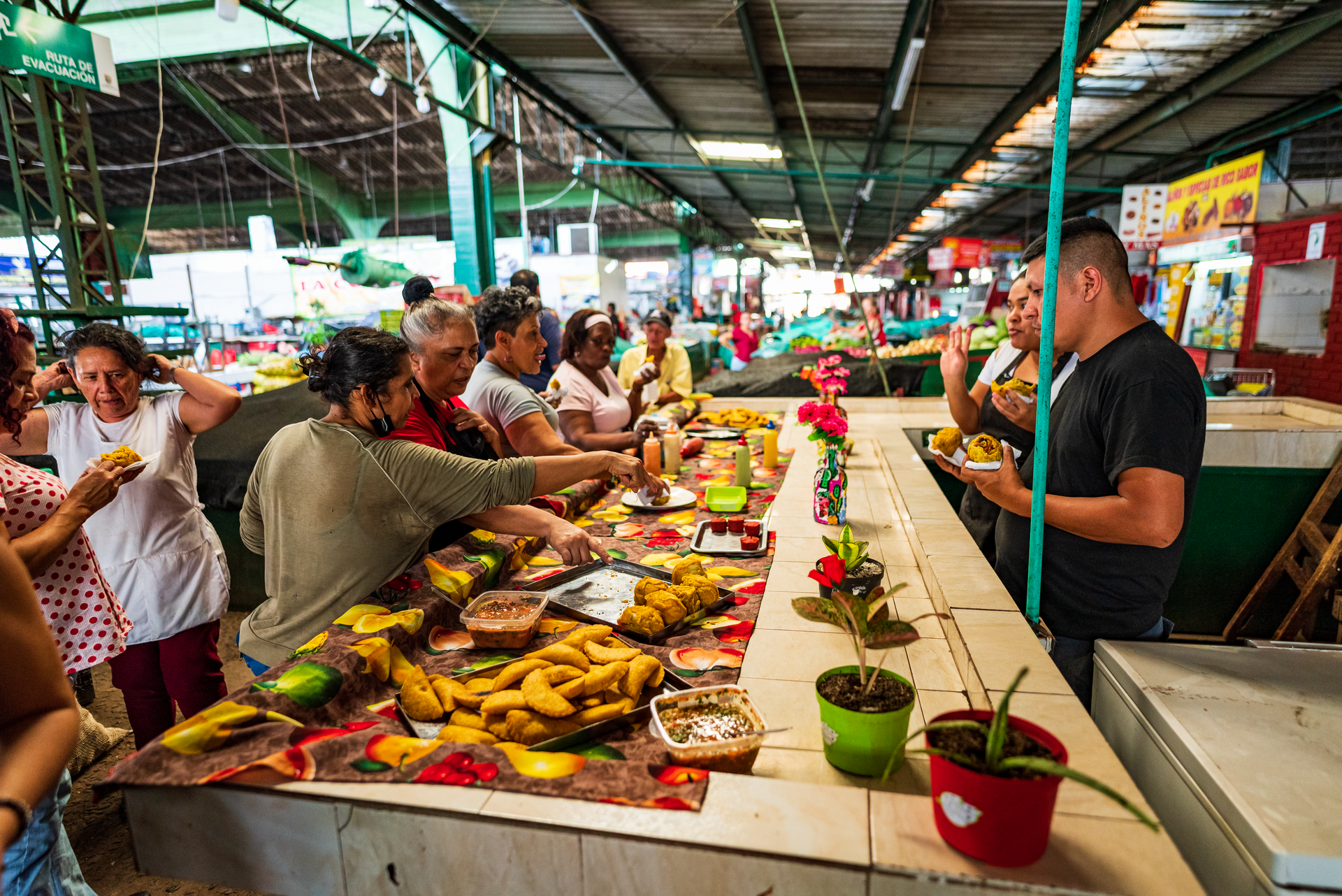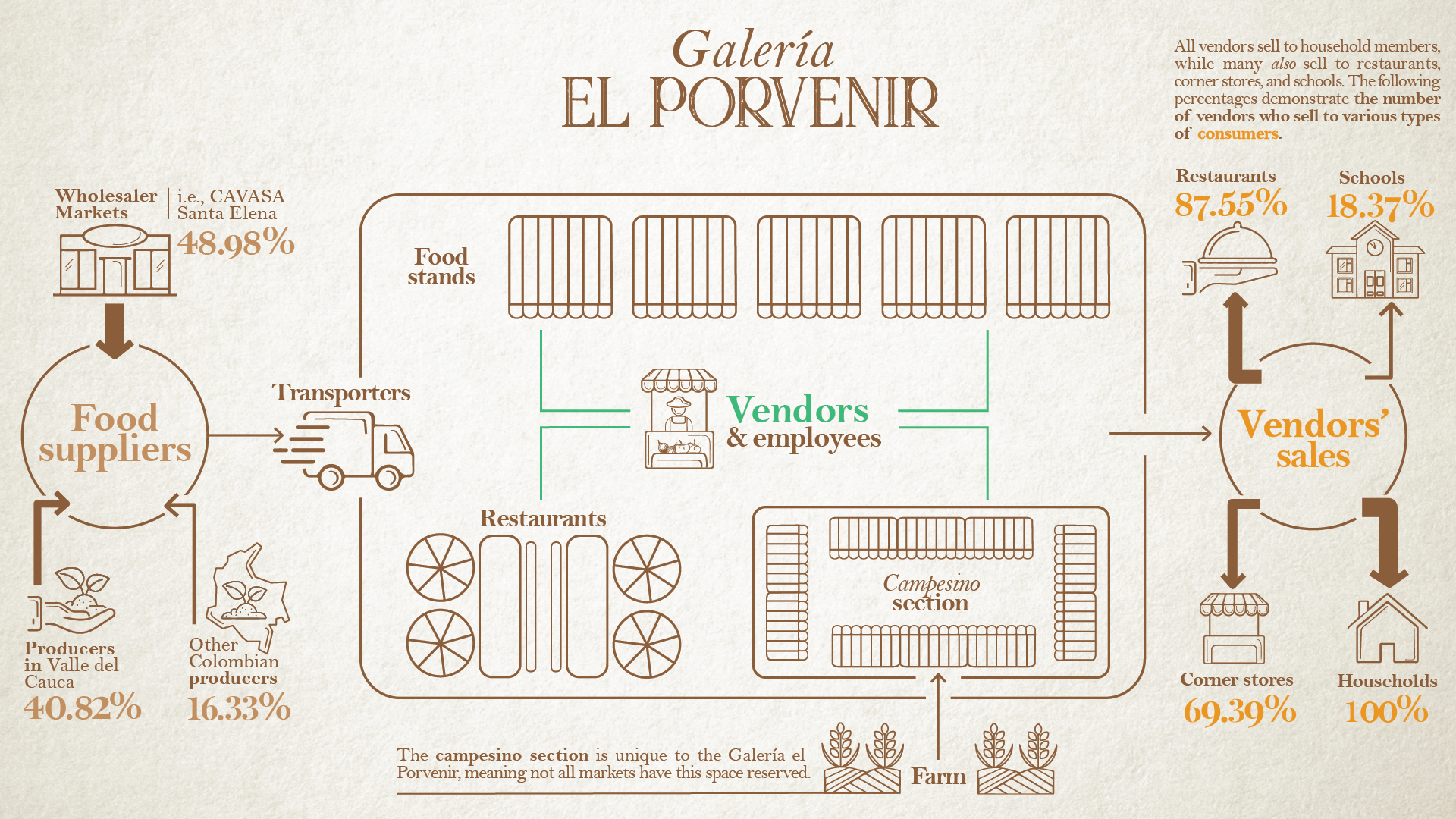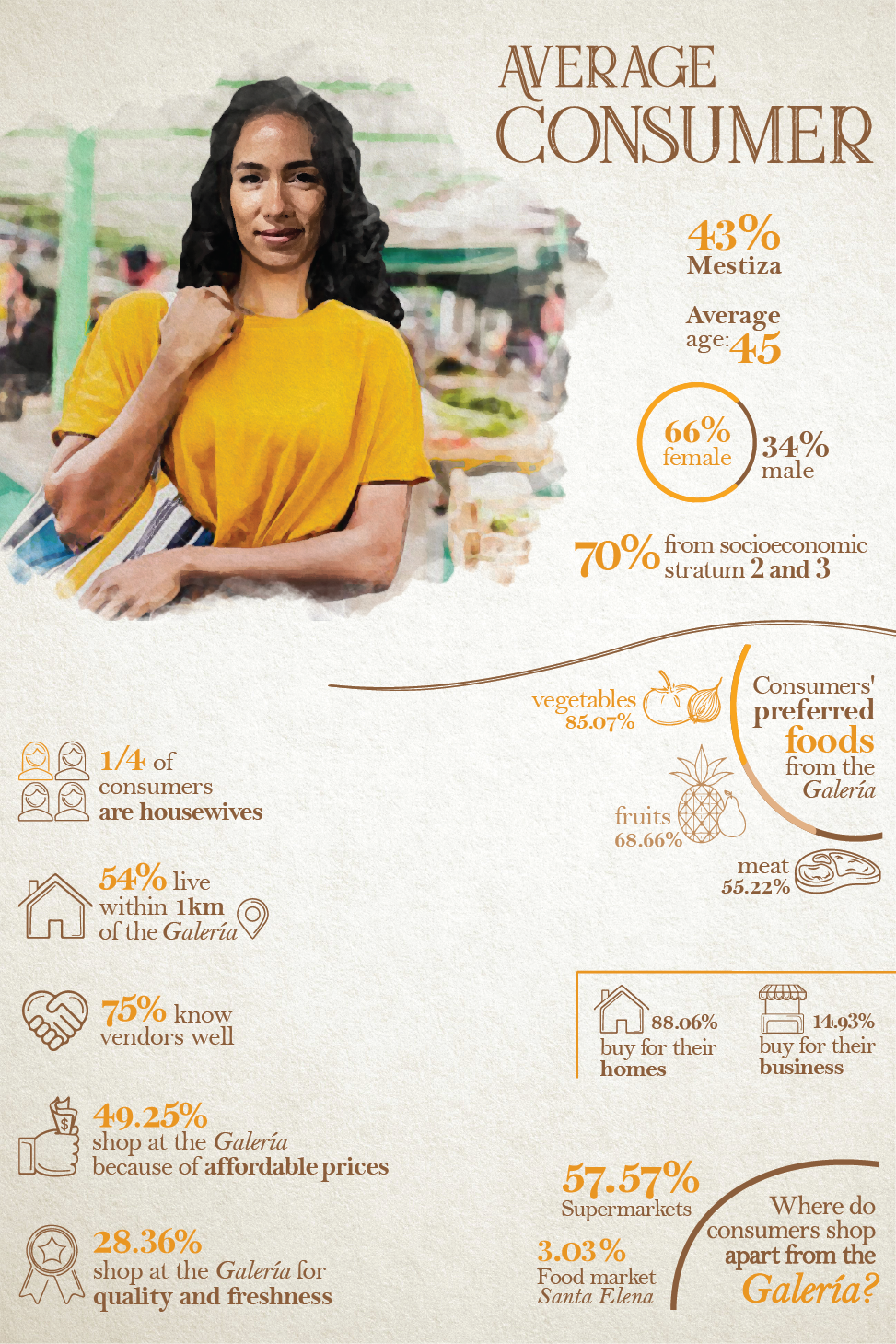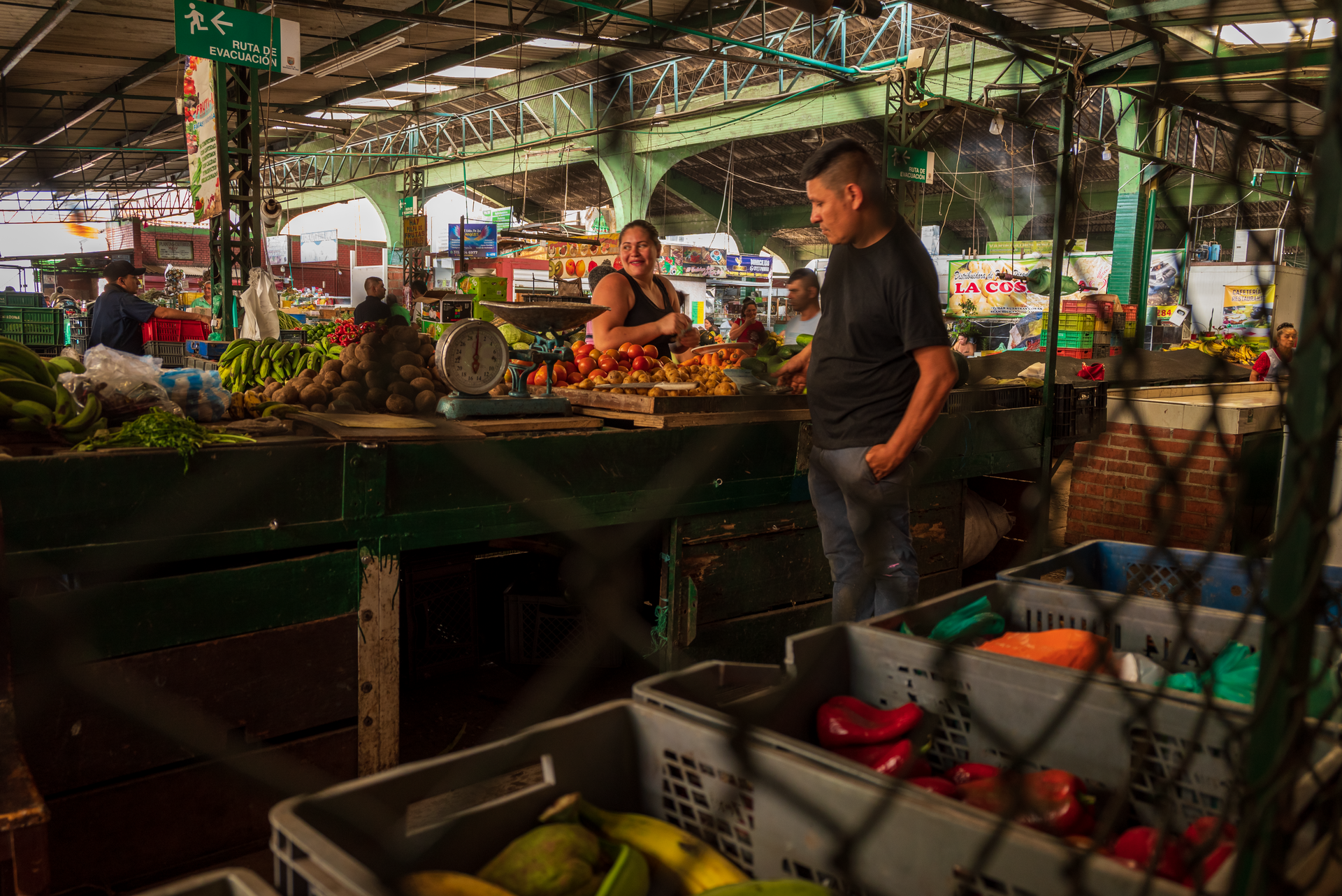From the Field Lessons from a Traditional Colombian Food Market

What food flows in the Galería El Porvenir Market reveal about Cali & Colombia.
On a typical day in a traditional Colombian food market, the “Galería,” a shopper can go from having a chat with a campesino (farmer) about the land they steward to enjoying a filling meal based on a family recipe. They can step back and admire all walks of life converging in the hunt for low-cost, high-quality, traditional ingredients. Galerías are major players in the city’s “food environment” – the space where consumers make the food choices that offer flavor to their daily lives. The affordability, accessibility, convenience of preparation, and desirability of ingredients in the Galerías all play a significant role in determining peoples' food choices, diets, and consequently nutrition and health.

Alliance Visiting Researcher, Alex Reep, interviewing campesino produce vendor Luz Dila. Photo by: Fabián Villa.
The city of Santiago de Cali is fortunate to have six traditional food markets, the Galerías Porvenir, Alameda, Santa Elena, La Floresta, Alfonso Lopez and Siloe. These Galerías offer more than food — they are local centers of social, cultural, and economic development, which offer employment opportunities and healthful ingredients used to preserve local gastronomic traditions. The widespread sugarcane plantations in the Valle de Cauca and a pervasive lack of cold chain storage have resulted in decreased agricultural diversity and an increased reliance on processed shelf-stable foods (1). As a result, the Galerías have become one of the most affordable options for accessing fresh food. Both market vendors and campesinos sell produce directly from farms, making the Galerías a meeting point between the city and countryside.

Food flow map of Galería El Porvenir. Design by: Carolina Polo
Across Latin America, there are big data gaps on food systems, particularly on the food flows through traditional market channels. What can we learn from one market in a specific city in a middle income country? In 2022, as a visiting researcher at the Alliance of Bioversity International and CIAT, I interviewed 116 market vendors and consumers in the Galería El Porvenir marketplace in Cali, Colombia. These conversations offered insight into what food is being offered, what is in high demand, where the city’s ingredients come from, and where they’re going. Beyond food flows, the interviews explored (1) markets’ capacity to feed people with time and budget limitations, (2) the price and perception of quality of the food being offered, and (3) what elements of these traditional markets should be considered in the development of policies to promote healthier and more sustainable diets.
Profile of a Galería Consumer and Vendor

Key information about the average consumer of Galería El Porvenir. Design by: Carolina Polo.
The average Galería consumer is a middle-aged Mestiza woman who buys ingredients for her household in a lower income neighborhood of the city – very likely only one or two kilometers from the market itself. She likes shopping in the Galería because she appreciates the low prices, proximity to home, personal relationships with the vendors, and the freshness of the produce and meats. When she can’t find what she’s looking for at the Galería, she’ll visit a supermarket to find grains or processed foods because there’s greater variety and the stores are open longer hours.
The average Galería vendor is a middle-aged Mestizo man, with a primary or secondary school education, who has owned his food stand for over 30 years and doesn’t sell anywhere else. He sources his products from merchants he likely doesn’t know well, in Cali or just outside Cali — particularly the wholesale markets CAVASA and Santa Elena. In an average week, he’ll sell to between 10 to 70 customers. The greatest threats to his business are the rising price of products, the high cost of transportation, and competition from supermarkets and other vendors in the Galería. He wastes very little food, if any at all, because leftovers are discounted or donated.

Key information about the average vendor of Galería El Porvenir. Design by: Carolina Polo.
Results and desirable future actions
● Addressing Budget Limitations: Vendors want to revitalize the Colombian tradition of shopping at the Galería by improving the appearance of and experience within the space. Of the surveyed vendors, 74% agreed that the best way to attract more consumers is to find a way to lower prices. Vendors proposed creating a union of Galería vendors to compete with big markets that benefit from larger purchasing power, in addition to having the Galería’s administrative staff coordinate with intermediaries to facilitate sourcing food products for vendors (who typically work and negotiate alone). Finally, many consumers recognized that the more middle-men involved to bring the food to the market, the costlier the food product. Beyond an appreciation for fresh produce from the farms, a consumer explained that “intermediaries cause prices to rise, so it would be better to buy directly from campesinos.”
● Assessing Price Fluctuations & Food Quality: Shoppers in the Galería tend to be hyper-aware of changes in price (month to month, week to week, stall to stall), in addition to how the causes of unstable prices affect food quality and availability. Forty percent of surveyed consumers attributed price fluctuations to increasingly variable weather conditions, where extreme heat dries fields and intense rainstorms destroy crops, accelerate rot, and debilitate highways. One patron summarized, “the climate is changing a lot, so the prices are changing too.” Beyond rain, complications from the COVID-19 pandemic and road shutdowns during the national strikes of 2021 have caused record-level transportation and supply chain disruptions in Cali over the past two years. One consumer noted that “after the pandemic and national strike, everything changed. All prices started rising, prices rise every time we shop, and very few things become more affordable. Now, we've become accustomed to buying and using less — rationing." Further, several interviewees connected the 2022 war in Ukraine with the rising prices of agricultural inputs like fertilizers and pesticides, and thus the increasing cost of everyday ingredients. “Ultimately,” one consumer summarized, “(prices) all depend on the globe's socioeconomic and sociopolitical situation.”
● Promoting Healthy Diets: Approximately half of surveyed vendors (51%) and consumers (53%) emphasized the importance of improving the infrastructure, appearance, and hygiene within the Galería as means of keeping food products safe and competing with supermarkets. Forty percent of consumers mentioned a need for greater educational campaigns to teach the public about what food is nutritious, where their food comes from, the benefits of eating a healthy diet, how to buy fresh ingredients on a budget, and how to prepare food in a safe way that saves time and minimizes waste. Given their unique ability to serve and nourish people with time and budget limitations, one consumer noted that Galerías can strategically help us “increase our recognition that we are what we eat and that we're lucky to have rich soil and nutritious agricultural products.”
Key takeaways
The Galería offers an opportunity for people of all backgrounds to find fresh ingredients and to learn more about their local food system. Despite the fact that the majority of food vendors source their products through intermediaries, rather than directly from small scale producers, many workers have family connections with the countryside and bring ancestral knowledge and rural traditions to the Galería. Everyday consumers are also extremely knowledgeable about the influence of global hyperinflation, the effect of Colombia’s export-heavy economy, and the impact of wars, strikes, and supply chain disruptions. People of all educational and socioeconomic backgrounds discussed the consequences of agroindustry and monoculture cropping systems on Colombia’s fragile biodiverse ecosystems.
A consistent theme from conversations with both market consumers and vendors was a deep appreciation for food products from campesinos – which are a valuable component of the Galerías. People expressed that public policies and governmental subsidies should support campesinos directly in order to reduce agroindustry monocultures (and, thus, the use of chemicals in Colombian agriculture), increase the availability of organic produce for market consumers, and support agricultural livelihoods as a means of protecting the countryside from rural violence by offering productive alternatives for young people. Vendors suggested that the Galería should add signs in the campesino section to advertise that it’s an ecological or organic market. The leader of the Porvenir Marketplace Association (Asopor), Yeisy Duran, added that, “everyone should help the campo, because it sustains us all.”

Vendor Celso Elvis Ordóñez in the middle of a work day in the Galería. Photo by: Fabián Villa.
Primary lesson: treasure the Galería
The marketplace paints a picture of Colombian life in this place and time: the crops grown in the Valle del Cauca this season, the myriad of people that influence the city (from the Pacific Coast to the Southern and Central Andes), and the ingredients that feed the restaurants and citizenry of Cali. Lessons from the Galería el Porvenir case study can be applied to public policy initiatives to address the barriers that food producers face at establishing long-term economic profitability, in addition to the barriers consumers face in accessing fresh, affordable, and nutritious food. Given the cultural and socioeconomic importance of Galería, concerns of degrading infrastructure (ceilings, electric system, plumbing), in addition to sanitation and safety, should be taken seriously by local governmental agencies and addressed to protect consumers and vendors alike. The Galería is a unique space that combines campesinos, chefs serving traditional comfort food, knowledgeable and experienced vendors that know the best of their product, and consumers from all sectors of Colombian society. It reminds us that our consumption is an opportunity to promote conservation: when we buy local products grown in the unique environmental conditions surrounding our city, we promote small-scale farmers’ efforts to preserve ingredients that color our collective palates. There’s a reason why Galería is a term used for both food and fine art.
References
1 Aronson, S. 2019. Cali’s Food Systems: A Diagnostic Synthesis to Determine Priority Action Areas for Sustainable Food Systems
Click to download publication
